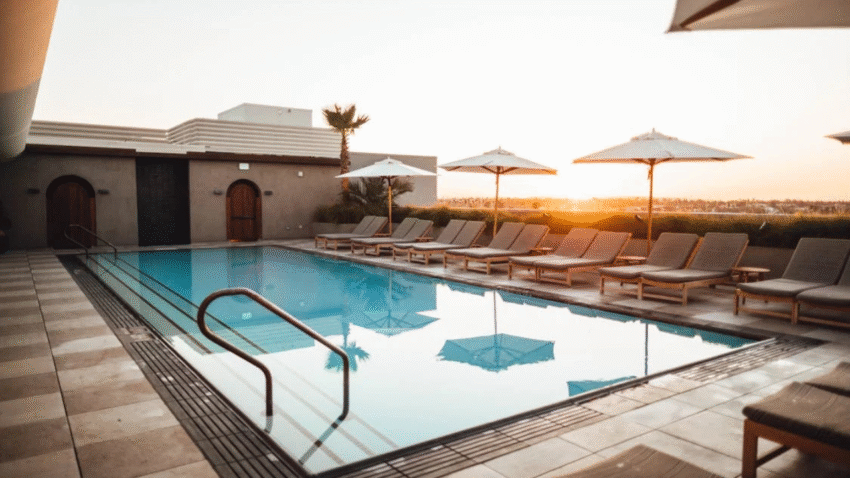Introduction
Dreaming of relaxing in a bubbling spa without building a brand-new setup? You’re not alone. Learning how to add a spa to an existing pool is a fantastic way to level up your backyard oasis without starting from scratch. In this step-by-step guide, we’ll walk you through everything from planning to plumbing so you can enjoy soothing hydrotherapy right alongside your swimming pool.
Why Adding a Spa Matters for Your Pool
Adding a spa to your existing pool offers more than just luxury—it’s a smart investment in comfort, relaxation, and year-round usability. Whether you want to unwind after a long day or soothe sore muscles, a built-in spa adds value to your property and enhances your pool’s overall functionality.
From a design perspective, a spa can create a stunning focal point and improve water circulation through shared systems. For pool owners already maintaining filtration, pumps, and heaters, adding a spa may only require moderate upgrades rather than a full install. Best of all, it opens the door to therapeutic benefits without leaving your backyard.
Step-by-Step Guide to Adding a Spa to Your Pool
Step 1: Decide on the Spa Style (Integrated vs. Spillover)
The first step is choosing the type of spa that suits your pool and backyard layout.
- Integrated Spa: Built into the pool structure itself, creating a seamless visual and functional experience.
- Spillover Spa: Slightly elevated and designed so that water spills into the pool, offering soothing visuals and sound.
Each option has different plumbing and construction needs, so consult a professional to determine compatibility.
Step 2: Consult with a Pool Contractor
Adding a spa is not typically a DIY job. Hire a licensed pool contractor or builder to:
- Assess your current pool design and structure
- Verify your pool’s existing plumbing and heating capacity
- Create a detailed plan with cost estimates
A contractor will also ensure that your project complies with local building codes and permits.
Step 3: Plan the Plumbing and Equipment
Your new spa will need access to the pool’s circulation system. Here’s what needs to be considered:
- Shared vs. Separate Pumps: You may use your pool’s existing pump or install a dedicated one for the spa.
- Heater Compatibility: Spas require higher water temperatures. Upgrade to a dual-capacity heater if necessary.
- Jet Plumbing: Spa jets require dedicated plumbing lines and air supply systems.
Upgrading your pool control system to manage both the pool and spa functions efficiently is often worth the investment.
Step 4: Excavation and Construction
Once plans are approved, construction begins:
- Excavation: The spa area is dug out, typically near the shallow end of the pool.
- Steel and Shell: A steel frame is constructed, then sprayed with gunite or concrete to create the spa’s shell.
- Plumbing Installation: Pipes and jets are added before the surface is sealed and cured.
This step can take several days depending on weather, contractor availability, and design complexity.
Step 5: Surface Finishing and Tiling
After structural curing:
- Apply plaster, pebble finish, or tile to match or complement your existing pool.
- Install seating contours and internal spa lighting if desired.
This is the step where your spa begins to visually come to life.
Step 6: Integrate Controls and Test the System
Finally:
- Install control systems (manual or digital) to operate jets, temperature, and lighting.
- Test all components: plumbing, heater, and electrical systems.
- Fill the spa and test for leaks or pressure issues.
Once all systems pass inspection, your spa is ready for use!
Common Mistakes to Avoid
- Skipping Permits and Inspections
- Mistake: Adding a spa without proper approvals.
- Fix: Always work with licensed professionals who understand local codes.
- Underestimating Heater Needs
- Mistake: Using an undersized heater that struggles to warm the spa.
- Fix: Upgrade to a heater designed for spa temperatures (typically 100–104°F).
- Improper Jet Placement
- Mistake: Placing jets too low or unevenly.
- Fix: Work with experienced designers to optimize jet positioning for therapeutic effect.
- Overloading the Existing Pool System
- Mistake: Adding a spa to an old or weak pool system.
- Fix: Evaluate pump, filter, and plumbing capacity early in the planning phase.
- Ignoring Future Maintenance
- Mistake: Failing to factor in extra maintenance or chemical balancing.
- Fix: Treat spa maintenance as part of your overall pool care plan.
Extra Tips & Pool Hacks
- Consider Automation: Install an automated system like Pentair IntelliTouch or Hayward OmniLogic to control pool/spa settings from your smartphone.
- Energy Efficiency: Use a spa cover to retain heat and reduce energy costs.
- Aesthetic Upgrade: Add LED lighting or a fire feature around the spa for nighttime ambiance.
📖 Related article: [How to Use Chlorine Tablets Effectively] for managing chemical balance in both pool and spa systems.
Conclusion
Adding a spa to your existing pool is a fantastic way to enhance your backyard’s functionality and luxury. From choosing the right design to understanding plumbing needs and system upgrades, this guide walks you through each essential step. With proper planning and professional help, your new spa can be the highlight of your home’s outdoor space.
👉 Bookmark this guide and revisit it when you’re ready to dive into your spa project!
